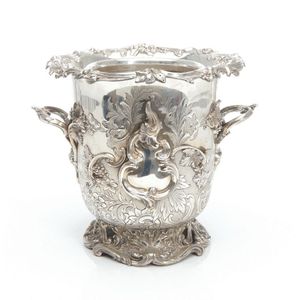19th Century Sheffield Plate Wine Cooler
You must be a subscriber, and be logged in to view price and dealer details.
Subscribe Now to view actual auction price for this item
When you subscribe, you have the option of setting the currency in which to display prices to $Au, $US, $NZ or Stg.
- Sheffield Plate - Sheffield plate was the first commercially viable method of plating metal with silver. The method of plating was invented by Thomas Boulsover, a Sheffield Cutler, in 1743 and involved sandwiching an ingot of copper between two plates of silver, tightly binding it with wire, heating it in a furnace and then milling it out in to sheet, from which objects could be made.
Originally used by its inventor to make buttons, the potential of the material was quickly realised, and soon it was being used to fashion boxes, salvers and jugs, and not long after that candlesticks and coffee pots, and other traditional tableware.
Although there was a considerable saving in the amount of silver used, Old Sheffield Plate manufacture was more labour intensive than solid silver, meaning higher labour costs. This meant that Old Sheffield Plate was very much a luxury product, and only available to the very wealthy.
The thickness of the silver means that many 18th century Sheffield Plate pieces still have a good layer of silver, while electroplated pieces (EPNS), may have been replated several times over their lifetime. Where the silver has worn off the Sheffield plate the soft glow of the copper base can be seen underneath. However this is not an infallible guide that the piece is Sheffield Plate, as many EPNS items were also plated on to a copper base.
Most Sheffield plate items are unmarked, whereas most elecroplated items display manufacturers names or marks, quality indications such as "A1", "EP", together with pattern or model numbers.
Sheffield plate was made commercially between 1750 and 1850.
This item has been included into following indexes:
Visually similar items

A Victorian sterling silver floral christening mug by James C. Edington, London 1858, 10 cm high 180grams

A George IV silver tankard. Maker: Alexander Edmonstoun III, Edinburgh 1825. Date letter: 'T'. inscribed: 'A.P.'. Weight: 191 grams.

A beautiful George III sterling silver wine cooler depicting scenes of half-naked women from the island of Lesbos or Lemnos, where a race of women killed their menfolk and loved drinking wine.

English hallmarked sterling silver Victorian Christening mug having a round hand-chased body with floral and scroll-work decoration, an elaborate scrolled handle, sitting on a raised floral pedestal foot, London, 1863, maker Chawner & Co, height 10.7 cm, w
